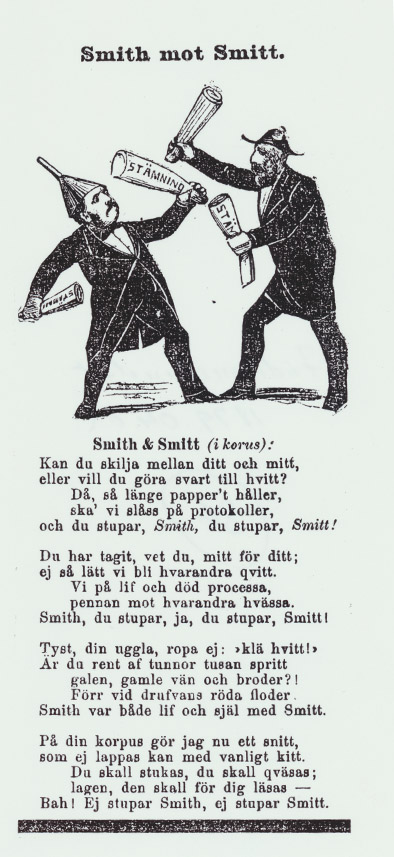
Johan Willhelm Smitt – L.O. Smith’s investor and enemy
L.O. Smith and Johan Willhelm Smitt were close business partners, but ended up as bitter enemies in court. Their disputes could be followed by the public, as they were published as open letters in the newspapers. Smitt was the man behind the so-called Reymersholme coup, and some say that he was also responsible for the Spanish export failure. What else do we know about Smith’s worst enemy?
Smitt’s background
Johan Wilhelm Smitt had a colorful past. When he worked as a bookkeeper at the age of 19, he was invited to join a sailing trip around the world. The adventure started in 1840, when the brig Oscar left Stockholm with Lieutenant André Oscar Wallenberg as chief mate. Soon, the ambitious sailors ran into problems with the brig. When they stopped in Lisbon for repairs, André Oscar Wallenberg left the ship. Smitt remained on board and in August 1841, he arrived in Buenos Aires, Argentina.
He had ended up in an area troubled by war. Despite the conflict, Smitt set himself up as a merchant and started trading. His trading house focused on peaceful business deals and business went well. He also bought 20 square kilometers of land in Uruguay, where he carried out large-scale livestock farming and ran a vineyard. In the mid-1850s, he decided to sell his businesses in South America and returned to Sweden as a wealthy man.
In Stockholm, he started spending time with André Oscar Wallenberg again. In 1856 he became one of the founders of Stockholms Enskilda bank. After a dispute about overly generous dividends, he cut off his contact with Wallenberg. He was also involved in setting up Stockholms Handelsbank, later Svenska Handelsbanken. In 1859, he founded Stockholms Bryggeri AB. The company later became S:t Eriks Bryggeri AB, where he acted as chairman of the board.
Partners and enemies
Smitt collaborated with practically all prominent businesspeople of his time, including L.O. Smith, of course. In the autumn of 1867, Smith and Smitt formed Inedals Sockerfabriks AB with the intention of producing sugar on a large scale. They ordered machines from abroad and built a factory in the Stockholm district of Kungsholmen. Already in the first financial year, however, the company ran into problems. Following a disagreement within the board, Smith resigned as chairman.
A few years later, Smith contacted Smitt again. He needed capital to be able to rebuild the Reymersholme factory. The business didn’t take off as he hoped, however. The cautious Smitt started worrying and asked to have his investments back. The conflict was blown up in the newspapers, and the question was finally settled in court. L.O. Smith was sentenced for defamation, but the investment issue remained unresolved.

Alfred Nobel’s business
In 1864, Johan Smitt decided to invest in Alfred Nobel’s business. He bought land for a future factory at Vinterviken, located in the area known today as Aspudden in western Stockholm. He arranged permission to manufacture and store nitroglycerin, and was also involved as both chairman of the board and informal CEO. In 1865, Smitt raised a loan that enabled Alfred Nobel to build a factory outside Sweden.
Smitt’s most successful deal was perhaps the one he did in 1866. He bought a large piece of land around Reparebangatan (today’s Fleminggatan) at Kungsholmen in Stockholm, an area which was largely rural at the time. By taking over the Cederwald fee tail for 175,000 SEK (around 11 million SEK in today’s value), he became the owner of all vacant lots along the street. As Stockholm expanded westwards in the 1880s, he sold the lots for 2,000,000 SEK (about 120 million SEK in today’s value). After building “Smitt’s Palace”, an ore yard in the corner of Scheelegatan-Fleminggatan, he became known as “the king of Kungsholmen”. He also had business interests in numerous other companies, such as Stockholms Yllefabrik (a wool factory), Stockholms superphosphate factory, Stockholms Allmänna Telefon AB, Graningeverken (a group of companies that included a sawmill and a hydropower station), Sundsvalls Enskilda Bank and Aftonbladet (a national newspaper). He contributed 100,000 SEK when Stockholm University was founded in 1878, and donated considerable sums to the university later on.
Johan Wilhelm Smitt died on October 8, 1904. According to the wishes in his will, his funeral was ”simple, without wreaths and flowers, and without speeches…”. The inventory confirmed that his wealth amounted to around 18 million SEK, or just over 1 billion SEK in today’s value.